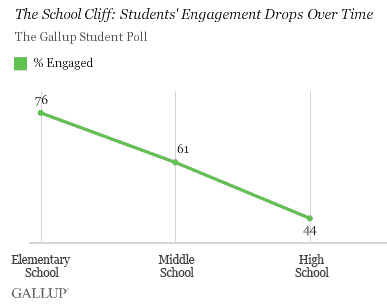Many Americans are relieved that government leaders in Washington avoided the fiscal cliff. However, there is another cliff to be aware of, one with implications that are far more frightening for the future of our country: the school cliff.
Gallup research strongly suggests that the longer students stay in school, the less engaged they become.
The Gallup Student Poll surveyed nearly 500,000 students in grades five through 12 from more than 1,700 public schools in 37 states in 2012. We found that nearly eight in 10 elementary students who participated in the poll are engaged with school. By middle school that falls to about six in 10 students. And by high school, only four in 10 students qualify as engaged. Our educational system sends students and our country's future over the school cliff every year.

Student engagement with school and learning is a gold standard that every parent, teacher, and school strives to achieve. If we were doing right by our students and our future, these numbers would be the absolute opposite. For each year a student progresses in school, they should be more engaged, not less.
These results are from the fourth annual administration of the Gallup Student Poll. Schools opt to participate in the poll to measure the hope, engagement, and well-being of their students in grades five through 12. Gallup measures these three constructs because our research shows these metrics account for one-third of the variance of student success. Yet schools don't measure these things. Hope, for example, is a better predictor of student success than SAT scores, ACT scores, or grade point average.
The drop in student engagement for each year students are in school is our monumental, collective national failure. There are several things that might help to explain why this is happening -- ranging from our overzealous focus on standardized testing and curricula to our lack of experiential and project-based learning pathways for students -- not to mention the lack of pathways for students who will not and do not want to go on to college.
Imagine what our economy would look like today if nearly eight in 10 of our high school graduates were engaged -- just as they were in elementary school. Indeed, this is very possible; the best high schools in our dataset have as many as seven in 10 of their students engaged, akin to the engagement levels of our elementary schools. In fact, in qualitative interviews Gallup conducted with principals of these highly engaged high schools, we heard quotes such as, "Our high school feels like an elementary school," when describing what they are doing differently.
What's more, among the many types of students whose engagement wanes during their time in the educational system are those who have high entrepreneurial talent. These are literally our economic saviors -- the future job creators for America.
We not only fail to embrace entrepreneurial students in our schools, we actually neutralize them. Forty-five percent of our students in grades five through 12 say they plan to start their own business someday. That's a ton of entrepreneurial energy in our schools. Yet a mere 5% have spent more than one hour in the last week working, interning, or exposed to a real business. That would be our economic stimulus package right there. With each year that these students progress in school, not engaging with their dreams and thus becoming less engaged overall, the more our hopes of long-term economic revival are dashed.
Many of us will worry about the federal debt ceiling and the U.S. economy over the coming months. But if we want to secure our country's future, we need to save our kids from going over the school cliff.
Gallup Student Poll Methodology
The annual Gallup Student Poll is offered at no cost to public schools and districts in the United States. The online poll is completed by a convenience sample of schools and districts each fall. Schools participating in the annual Gallup Student Poll are not randomly selected and are neither charged nor given any incentives beyond receipt of school-specific data. Participation rates vary by school. The poll is conducted during a designated survey period and available during school hours Tuesday through Friday only. The Gallup Student Poll is administered to students in grades 5 through 12. The primary application of the Gallup Student Poll is as a measure of non-cognitive metrics that predicts student success in academic and other youth development settings.
Updated Jan. 7, 2013, with additional methodology information.

